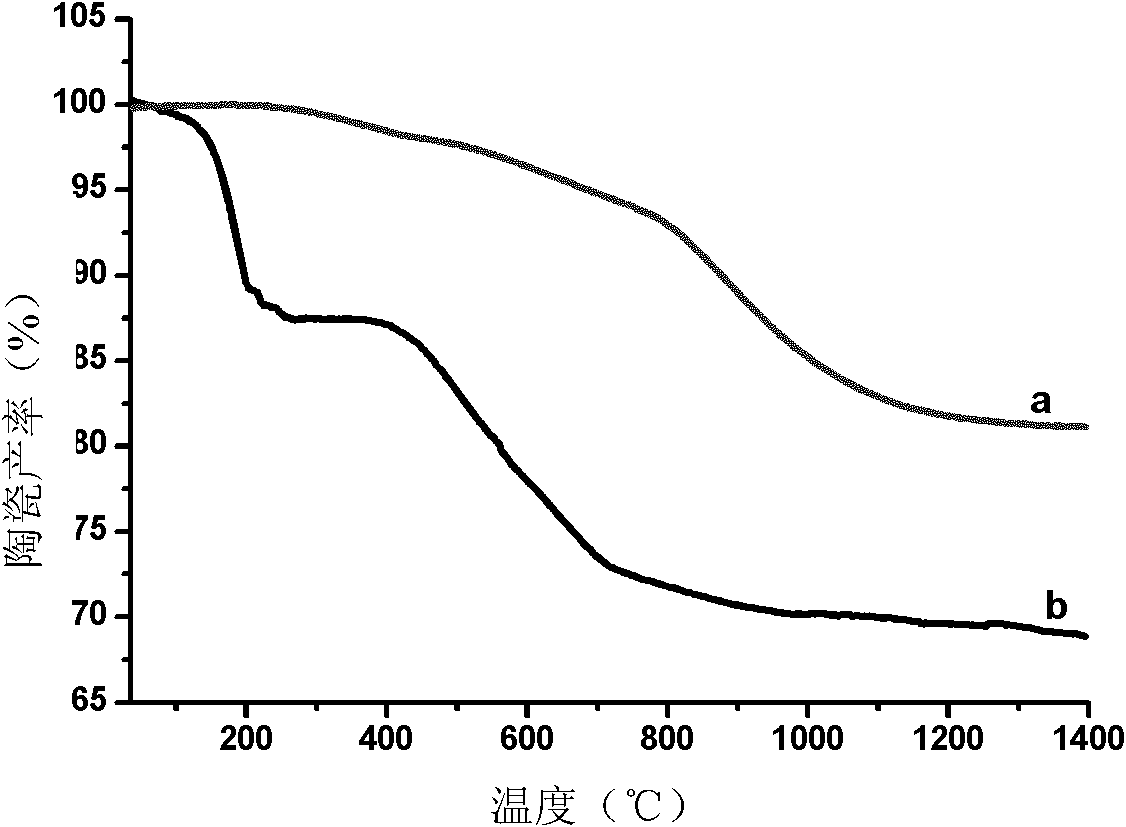Method for preparing silicon carbide/titanium carbide composite ceramics
A technology of composite ceramics and titanium carbide, which is applied in the field of preparation of silicon carbide/titanium carbide composite ceramics, can solve the problems of affecting high temperature resistance, growth of silicon carbide grains, and decline in mechanical properties, so as to improve the productivity of ceramics , controllable titanium content and high yield
- Summary
- Abstract
- Description
- Claims
- Application Information
AI Technical Summary
Problems solved by technology
Method used
Image
Examples
Embodiment 1
[0019] 1) Under the protection of an inert atmosphere, dissolve titanocene dichloride with dimethylformamide, stir, then add hyperbranched polycarbosilane, the quality of titanocene dichloride, hyperbranched polycarbosilane and dimethylformamide The ratio is 1:1:15;
[0020] 2) The mixture obtained in step 1) is distilled under reduced pressure to remove the solvent;
[0021] 3) The mixture obtained in step 2) was cracked at 1400° C. for 120 minutes under an inert atmosphere to prepare silicon carbide / titanium carbide composite ceramics.
[0022] The average structural formula of hyperbranched polycarbosilane is -[SiH 1.7 (CH 3 ) 0.2 (CH 2 CH=CH 2 ) 0.1 -CH 2 ] n -, determined by thermogravimetric analysis (TGA) (see figure 1 ), the ceramic yield of the hyperbranched polycarbosilane / dichlorotitanocene hybrid precursor at 1400°C was 81.1%, while the ceramic yield of the raw material hyperbranched polycarbosilane at 1400°C was 68.9%; the silicon carbide thus prepared / ...
Embodiment 2
[0024] 1) Under the protection of an inert atmosphere, dissolve titanocene dichloride with tetrahydrofuran, stir, then add hyperbranched polycarbosilane, the mass ratio of titanocene dichloride, hyperbranched polycarbosilane and tetrahydrofuran is 1:3.3:65;
[0025] 2) The mixture obtained in step 1) is distilled under reduced pressure to remove the solvent;
[0026] 3) The mixture obtained in step 2) was cracked at 1300° C. for 10 minutes under an inert atmosphere to prepare silicon carbide / titanium carbide composite ceramics.
[0027] The average structural formula of the raw material hyperbranched polycarbosilane used is-[SiH 1.5 (CH 3 ) 0.5 -CH 2 ] n -, as determined by thermogravimetric analysis (TGA), the ceramic yield of the hyperbranched polycarbosilane / dichlorotitanocene hybrid precursor at 1300°C was 76.4%, while the ceramic yield of the raw material hyperbranched polycarbosilane at 1300°C is 67.5%; the chemical composition of the silicon carbide / titanium carbid...
Embodiment 3
[0029] 1) Under the protection of an inert atmosphere, dissolve titanocene dichloride with chloroform, stir, then add hyperbranched polycarbosilane, the mass ratio of titanocene dichloride, hyperbranched polycarbosilane and chloroform is 1: 2:30.
[0030] 2) The mixture obtained in step 1) is distilled off under reduced pressure in vacuo to remove the solvent.
[0031] 3) The mixture obtained in step 2) was cracked at 1400° C. for 30 minutes under an inert atmosphere to prepare silicon carbide / titanium carbide composite ceramics.
[0032] The average structural formula of the raw material hyperbranched polycarbosilane used is-[SiH 1.5 (CH 3 ) 0.3 (C≡CH) 0.2 -CH 2 ] n -, as determined by thermogravimetric analysis (TGA), the ceramic yield of the hyperbranched polycarbosilane / dichlorotitanocene hybrid precursor at 1400°C was 82.1%, while the ceramic yield of the raw material hyperbranched polycarbosilane at 1400°C is 72.9%; the chemical composition of the silicon carbide / ...
PUM
| Property | Measurement | Unit |
|---|---|---|
| Size | aaaaa | aaaaa |
| Grain size | aaaaa | aaaaa |
| Size | aaaaa | aaaaa |
Abstract
Description
Claims
Application Information
 Login to View More
Login to View More - R&D
- Intellectual Property
- Life Sciences
- Materials
- Tech Scout
- Unparalleled Data Quality
- Higher Quality Content
- 60% Fewer Hallucinations
Browse by: Latest US Patents, China's latest patents, Technical Efficacy Thesaurus, Application Domain, Technology Topic, Popular Technical Reports.
© 2025 PatSnap. All rights reserved.Legal|Privacy policy|Modern Slavery Act Transparency Statement|Sitemap|About US| Contact US: help@patsnap.com


